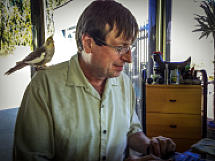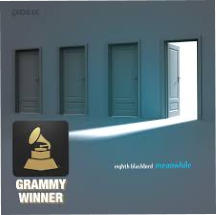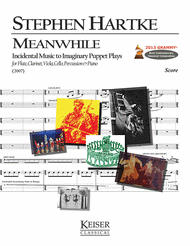
Stephen Hartke
Meanwhile
MEANWHILE (2007)
Incidental Music to Imaginary Puppet Plays
for Flute (doubling Piccolo and Alto Flute), Clarinet (doubling Bass Clarinet), Viola,
Cello, Percussion, and Piano
Commissioned for eighth blackbird by the Barlow Endowment for Music Composition
at Brigham Young University
Winner 2013 GRAMMY Award for Best Contemporary Classical Competition
Duration: 18 Minutes
Meanwhile was composed on a commission from eighth blackbird and the Barlow
Endowment for Music Composition at Brigham Young University. It is one of several
works of mine that has grown from a long-standing fascination I have had for various
forms of Asian court and theater music, and from a fantasy in which I imagine myself the
master of my own fictional non-Western musical tradition. In preparing to write this
piece, I studied video clips of quite a number of puppet theater forms, ranging from the
elegant and elaborate, nearly-life-sized puppets of Japanese Bunraku, to Vietnamese
water puppets, both Indonesian and Turkish shadow puppets, and to classic Burmese
court theater that mixes marionettes with dancers who look and act like marionettes. All
of these theatrical forms have their own distinct musical styles and structures, and I
confess to being especially fascinated by the stark vividness of their instrumental
coloration and the often unexpected structural quirks that they have evolved as these
traditions have taken shape over the centuries and become stylized.
This piece, then, is a set of incidental pieces to no puppet plays in particular, but one in
which the imaginary scenes have given rise to an idiosyncratic sequence in which the
sound of the ensemble has been reinvented along lines that clearly have roots in these
diverse Asian models. The piano, for instance, is prepared for much of the piece with
large soft mutes used to transform the color of the middle register into something that
rather resembles the Vietnamese hammer dulcimer. The viola is tuned a half-step lower
in order both to change its timbre and to open the way for a new set of natural harmonics
to interact sometimes even microtonally with those of the cello. The percussion array
includes 18 wood sounds, from very high Japanese Kabuki blocks to lower range slit
drums, plus 4 cowbells, 2 small cymbals, and a set of bongos. These are set up in
keyboard fashion so that the player can play them all as a single instrument. Finally,
there is a set of Flexatones, which are rather like small musical saws. Three of these are
held together with a wooden clamp and are played by the pianist with a mallet, their
pitch being altered by pressing down on their metal flanges. The tone is rather like that of
small Javanese gongs, and so I have given this new instrument the name of Flexatone
Gamelan.
Meanwhile is played as a single movement, with 6 distinct sections: Procession, which
features the Flexatone Gamelan; Fanfares, with the Piccolo and Bass Clarinet linked
together much as a puppeteer and his marionette; Narrative, in which the Bass Clarinet
recites the 'story' of the scene in an extravagant and flamboyant solo reminiscent of the
reciter in Japanese Bunraku; Spikefiddlers, which requires a playing technique for the
viola and later the cello that stems from Central Asian classical music; Cradle-songs, the
outer parts of which feature natural harmonics in the viola and cello combined with bell-
like 9th-partial harmonics from the piano; and Celebration, where, in the coda, the Flutist
and Clarinetist take up Flexatones to play the closing melody.
Recording:
eighth blackbird
Cedille Records
90000 133


YouTube Video:
eighth blackbird
















